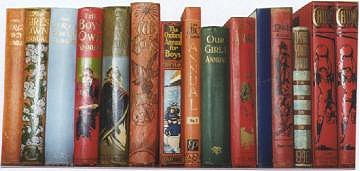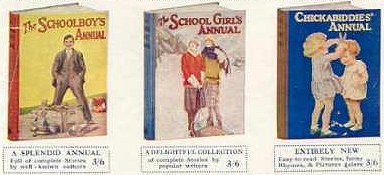 |
|

|
|
CHILDREN'S ANNUALS NEW!
|
Those of you over 40 will most likely be familiar with the BOY'S OWN ANNUAL and GIRL'S OWN ANNUAL. The term 'boy's own' is often used in the written media to describe stories of daring, written in the style of yesteryear. These two annuals, cornerstones though they are of any collection of English children's annuals, are merely at the tip of a very large iceberg. More than 800 titles are listed in Bill Lofts' and Derek Adley's OLD BOYS' BOOKS - A COMPLETE CATALOGUE, published in 1969. The term 'Old Boys' Books' is a misnomer, as girls' titles are listed as well. Twenty years ago, when I began to actively search for pre-war annuals, most collectors of juvenile books were male, and there was very little interest in girls' annuals. The situation has now swung the other way with far more interest in girls' annuals from both female and male collectors. In Australia, for example, the ratio of female to male collectors seems to be 10:1, at least on the eastern coast. Why? Younger male collectors of published material collect comics or trading cards. Mothers and grandmothers seem to have passed on their interest in old books to their daughters and grand daughters. According to an article by Lofts and Adley (the acknowledged experts in this field, although both Derek Adley and Bill Lofts have now passed away) in the English Book and Magazine Collector back in 1985 (issue #19), the first English annual to have included 'annual' within its title may well have been CHILD COMPANION ANNUAL (1824). CHILDREN'S PRIZE (later shortened to PRIZE) and CHATTERBOX arrived in 1863, BOY'S and GIRL'S OWN in 1878/9, YOUNG ENGLAND in 1880 and CHUMS in 1893. These annuals are generally well-known today among collectors. Many were assembled from either weekly or monthly issues of similarly named STORY PAPERS. |
 |
|

|
|
|
Three other early annuals worthy of note are THE CAPTAIN, BEETON'S CHRISTMAS ANNUAL and CHATTERBOX. The second is well known for the first appearance of Sherlock Holmes in 1887, while THE CAPTAIN's claim to fame was the regular appearance of P G Wodehouse among the list of contributors. Perhaps this annual shouldn't be referred to as such; it is usually found in half-yearly volumes composed of six monthly issues. With the arrival of the 20th Century, a number of publishers began producing annuals of original material. Worthy of note are the EMPIRE ANNUAL which produced BOYS and GIRLS volumes from 1909 onwards, and HERBERT STRANG'S ANNUAL FOR BOYS (from 1912) and MRS STRANG'S ANNUAL FOR GIRLS (1919-1926). Oxford University Press took over from the previous publisher (Froude/Hodder & Stoughton) in 1927, renaming them the OXFORD ANNUALS FOR BOYS and GIRLS. None of these annuals are particularly sought after unless they contain uncollected stories by currently popular girls' authors. Cassell published a series of annuals for the 'outposts of the Empire'. These were titles THE [point of sale] GIRL'S (or BOY'S) ANNUAL. Australian and New Zealand editions have been sighted; possibly Canadian, Indian and South African editions were also published, as well as the original British editions. These annuals appeared from 1911-1929, but were generally not dated after the first year. At some stage, the Amalgamated Press took over publication. Although of a smaller format than the BOY'S OWN and GIRL'S OWN, the earlier editions are superb examples of the period and often contain stories by currently collectable authors. It was after W.W.I that the most famous of children's annuals and story paper publishers entered the fray. The AMALGAMATED PRESS were already publishing dozens of weekly story papers (MAGNET, GEM, UNION JACK NELSON LEE, etc.) and comics (PUCK and TIGER TIM, etc.) and decided that there were profits to be made in the seasonal annual trade. Annuals were produced for the Christmas trade and were promoted from mid-October onwards in the weekly juvenile story papers. A point worth remembering: annuals usually displayed the following year. CHUMS 1936 went on sale towards the end of 1935. A typical Amalgamated Press ad for Christmas, 1935 offered 37 different annuals. The more collectible annuals of the 1930s include all the comic annuals (annuals containing comic strips) and the film annuals: FILM PICTORIAL, PICTURE SHOW, BOY'S CINEMA, etc. Prospective purchasers of film annuals should always carry out a page by page examination as it's not unusual to find sections and/or photos on a particular star removed. Pristine examples of these annuals are a rarity as most were given to young children as Christmas presents. 'Spin-offs' were also produced, as in the case of THE MODERN BOY. Apart from THE MODERN BOYS' ANNUAL, there were THE MODERN BOYS' BOOK OF ADVENTURE STORIES, FIRE-FIGHTERS, HOBBIES, PIRATES, RACING CARS, TRUE ADVENTURE, AIRCRAFT and MOTORS, SHIPS and ENGINES! The annual appeared from 1932-1941 while the specials appeared from 1936 onwards. Only one edition of the latter appeared but these would be sold each year while stock remained. Several of these annuals contain BIGGLES stories and other work of W E Johns, including colour reproductions of his delightful aircraft paintings. PIRATES was penned by Johns but FIRE-FIGHTERS is probably the rarest and most desirable of the titles listed. Other annuals worthy of note include the various Disney tie-ins published by Dean, D C Thompson's DANDY and BEANO, the Daily Express RUPERT, Odhams' DAN DARE and EAGLE, BOBBY BEAR. One of the better series to collect from the 1950s and 1960s is the LION series of annuals and spin-offs. Only EAGLE and BOY'S WORLD produced better series of annuals. You may have heard that real estate prices depend on three things, namely location, location - and location! For books, those three things are condition, condition, CONDITION! Many collectors of annuals may not be aware that most pre-WW2 annuals came in dust jackets. For a GIRL'S OWN thus endowed, you could expect to pay well over Aust$90 (45 pounds) if the book was in fine condition. In the first half of the 20th Century it wasn't unusual for careful collectors to remove the folding colour plates from annuals and store them flat, separately. Any would-be purchasers of long 'runs' of the above annuals would be wise to check that if the plates have been removed, they look for a cardboard folder in which said plates have been stored. These colour plates are of supreme importance, yet quite often they turn up at auctions, thrown in with piles of miscellaneous prints. A word of warning - many people who come across damaged copies of old annuals composed of apparently self-contained parts disassemble and offer the parts for sale as weekly or monthly issues, without realising that the genuine and relatively rare weeklies/monthlies came with additional pages of advertising and sometimes other weekly pages, usually distinguished by a sub-numbering system. In the Case of BOY'S OWN monthly parts, the additional pages were marked in Roman numerals on the leading lower edge of same (e.g. BOPiv). It's common to find CHUMS separated into parts, as the binding was of a particularly poor standard. What constitutes a fair price for these annuals? As much as you want to pay, which can be said for most items of a collectable nature. Reference
guide: The Children's Annual: A History and
Collector's Guide by Alan Clark, Boxtree Lon 1988
|
|
RADIO FUN ANNUAL 1950 Unique, so far as is known, in the field of Amalgamated Press dated children's annuals. Two different covers were published due to the star on the left passing away between the printing of the book and its distribution. The artist didn't have time to fill in the replacement version with characters.
|
|
| The actor featured on the first Bertie Brown cover, Tommy Handley (of ITMA fame), died soon after the annual was printed. A decision was made to hastily redesign it featuring Wilfred Pickles (of 'Have a Go!') which explains why there were less figures shown than on the original! This original design was believed to be extremely scarce but has turned up, mainly in Commonwealth countries, as supplies of the original were shipped overseas well ahead of the release date in the UK. Both of the copies shown were found in Sydney. |
|
Steve Holland
on the CHAMPION
ANNUAL FOR BOYS 1954 I would love to know the contents of the early annuals from the mid-1920s. Probably full of the above named authors under pseudonyms as well as Champion's other leading authors, which included Eric Townsend, whose first UK serial appeared here, I believe. Townsend was the pen-name of Eric W. McLean, born in the UK in 1901, but who may have lived in Australia at some point in his youth. There is a chance that his earliest stories appeared in Australian magazines (so that's something for you all to look out for). If my information is correct, Townsend's serial "The Bell of Santadino" which ran in Champion had been submitted to Boys' Realm in 1921 and had already appeared as a serial in an Australian mag. The main authors by the 1954 annual were our old favourites Edward R. Home-Gall, Eric L. Rosman, Frank S. Pepper and D. M. Cumming- Skinner. Pepper was responsible for two of the most popular series, Rockfist Rogan and Danny of the Dazzlers which ran in the weekly for years. Private eye Colwyn Dane was still in the annual, written by the pseudonymous Mark Grimshaw (probably written by Ernest McKeag, although other authors took over the name). THE DEMISE
OF ANNUALS But the third and
deciding factor I gather is that the news trade has
changed over the years. Annuals used to be based on
weekly comics and would get free promotion in the
associated comic for three months on the run-up to
Christmas. You can't promote tie-in annuals unless it's
to the general trade, which costs money. Also annuals
used to be "sale-or-return": you take ten
copies, you sell five, you return five for credit.
Basically a win-win situation for the shop keeper. But
nowadays annuals are "firm sale": you take ten
copies, you sell five, you get stuck with five unsold
annuals which cost you the profit you made on the other
five. The news trade did not take kindly to that
particular move (annuals were, after all, quite expensive
compared to what they're used to selling -- newspapers
which only cost a few pence), and orders withered, making
annuals unprofitable unless you thought you were onto a
guaranteed winner: thus, no more character annuals and
lots more pop star annuals. |
|
Back to Collecting Books & Magazines index If you have a question, please contact the page editor at chiefchook@gmail.com |